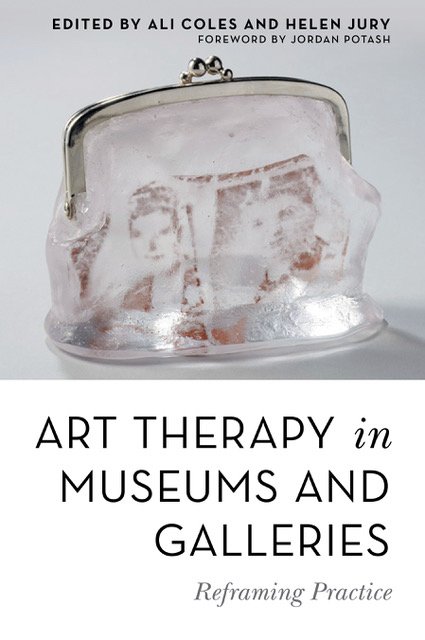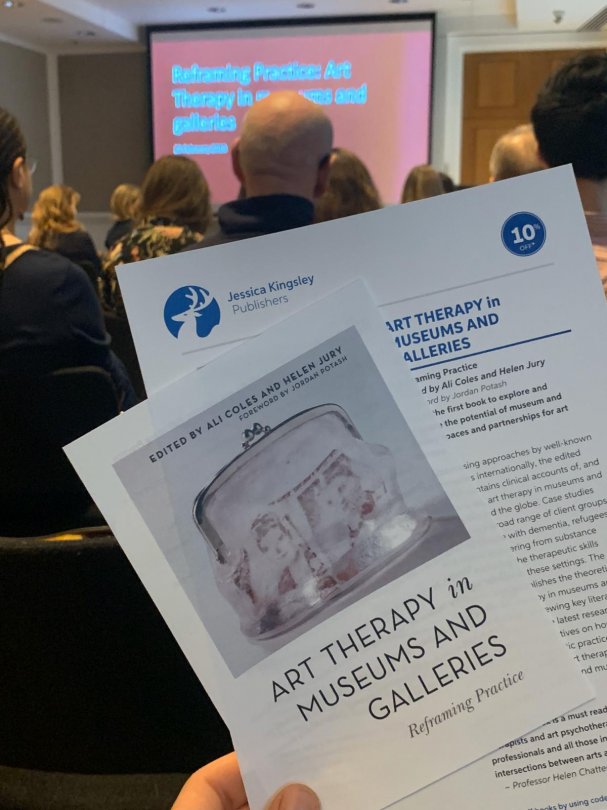
‘Art Therapy in Museums and Galleries – Reframing Practice’, edited by Ali Coles and Helen Jury, is a ground-breaking new book for art therapists, arts and health practitioners, and museum professionals alike. The notion of art therapy in museums and galleries has emphatically gained traction in recent years, most noticeably when the Montreal Museum of Fine Arts in Canada appointed a full time therapist in 2017 to its health, wellness and community programme, sending waves of excitement through members of MAGSIG, BAAT’s ‘Museums and Galleries Special Interest Group’ (www.atmag.org), who champion the research and practice of art therapy in such settings. Museums and galleries are perfect in many ways for art therapy - emotional connections can be made with artworks and objects, they can be used as inspiration for artmaking and the change in environment can feel like a welcome break from clinical settings.
As a learning curator, programme manager and youth worker in galleries prior to becoming an art therapist, this collection personally feels very exciting and relevant to my work, perfectly bridging the gap between the two sectors that have been an integral part of my professional life for over a decade. The book contains clinical accounts, case studies and reflections from across the globe, woven together to provide a compelling insight into partnership working, enabling a range of sectors to explore and evaluate the potential of museum and gallery spaces for art therapy.

On Saturday 29th February 2020, the book was launched at the National Gallery in London. A collaboration with the Gallery’s Community and Access Programme, the afternoon included authors sharing insights into their chapters, a short film from the Montreal Museum of Fine Arts (details below) and a panel discussion and Q&A led by Val Huet, CEO of BAAT. The launch sold out within hours of going live on the National Gallery website, indicating the strength of interest in this topic, and attendees included art therapists, museum professionals, arts in health practitioners, funders, researchers and interested members of the public.
Caroline Campbell, Director of Collections and Research at the National Gallery, introduced the event by inviting us to think about how we use art to make sense of who we are. She reflected on the use of public spaces to question identity and reminded us how important it is to take ownership of these spaces.
Anna Murray, Communities and Access Programmer at the National Gallery, echoed this sentiment, reflecting on how museums can be uncomfortable places for many of the population and stressed the importance of making collections useful. This captures the very essence of art therapy in museums and galleries - alternative approaches of viewing collections can inspire us to engage with personal responses, help reveal emotions and feelings, and promote social inclusion.
To round up the introduction to the launch, Val Huet elaborated further on the benefits of using museum and gallery collections as a resource for mental health and wellbeing.
The first presentation was by Helen Jury, who spoke about her chapter ‘Further Conversations with Rembrandt in Place, Space and Time’, where she examines the practice of art therapists keeping in mind the client’s artwork throughout therapy. The impossibility of seeing Rembrandt’s two self-portraits together, which were hung in different rooms at the National Gallery, initially informed her thinking about the time span between them and the sense of them being ‘states of mind apart’, similar to the different artworks produced in art therapy sessions. She explained the significance of the review of artwork, where all the client’s artwork is spread out in the room, comparing this to seeing every Rembrandt self-portrait gathered in one space. A sense of time contracting, and at times standing still, is something she suggested we notice; how it can be overwhelming for the client, and yet key to therapeutic engagement. The sense of literally re-viewing artwork is considered significant, alongside the role of the therapist in holding the experience of the client, aiding a co-construction of narrative.
Next, Ali Coles spoke about some of the ideas explored in her chapter ‘What Do Museums Mean?’, which looks at how the UK public views museums in general and implications for the use of museums for art therapy. For example, there are many parallels between the idea of museums as ‘custodians of heritage’ and the role of an art therapist, such as the way in which both museums and art therapists create safe and orderly ‘frames’, providing a holding and containing environment. There are also resonances between processes in art therapy groups and the way in which museums offer new perspectives and the chance to see the world through others’ eyes. Importantly, she noted that museums themselves are increasingly acknowledging that they are not unbiased, ‘neutral’ institutions, and talked about how art therapists can work with this dynamic to explore issues of power. She concluded that the general notions people hold about museums in the UK parallel key therapeutic principles within art therapy, suggesting that museums are natural partners for art therapy work.
Something that stuck in my mind from this presentation was the reflection of one of Ali’s clients feeling ‘like a person not a patient’ in the museum environment, and another who was drawn to a broken pot that symbolised the piecing together of her life; she enjoyed seeing that although cracked, the pot was still good enough for display.
Emma Hollamby, Manager of the Art and Dementia programme at the Ben Uri Gallery and Museum, spoke about looking at artworks as a stimulus for art therapy in dementia care. One of the few UK galleries to have a wellbeing programme, the Ben Uri collection comprises British and European art reflecting the work, lives and contributions of émigré artists and their journeys to London, with its core themes being identity and migration. Her chapter and talk focused on their programme ‘Starting with Art’, a partnership between the gallery and a dementia day care service, facilitated by a trainee art therapist on placement with the Ben Uri gallery. In her talk, Emma discussed how the programme was developed, which artworks were selected for the programme and why, and the evaluation and research that emerged from the programme. This was a fascinating glimpse into how such a programme is devised and delivered.
The final segment of the launch was a short film from the Montreal Museum of Fine Arts featuring chapter contributors and Programme Officers Marilyn Lajeunesse and Louise Giroux, with Stephen Legari, their in-house art therapist. The film talked about why their art therapy programmes exist, focusing on accessibility and the desire of the museum to break the stereotype of the standard museum visitor. Communities they work with include those affected by eating disorders, breast cancer and violent crime, to name a few. Their programmes have wellness at their core, sometimes using an open studio approach, and it was inspiring to learn about the many alternative ways in which meaningful encounters can take place at a museum.

The launch was rounded off with a panel discussion featuring some of the speakers from the day, together with chapter author Nana Zhvitiashvili, cover artist Pippa Beveridge and National Gallery Adult Learning Programmer Dr Christina Bradstreet, taking questions from the audience.
There was a great sense of excitement about the possibilities offered by museums/galleries and art therapy collaborations, for a range of client groups. There is a rich seam of work already taking place in the UK, and in the book this includes Mary Chamberlain’s work in Oxford, Simon Hackett, Ruth McGovern and Fiona Fitzpatrick working in drug and alcohol recovery in Tyne and Wear, Sheila Grandison in association with Tate London, and Michael Fischer and Whittaker Scott in collaboration with BALTIC in Gateshead. Sue Holttum’s chapter focusing on the relevant literature in this area of work helpfully frames the context. Further chapters discussing international work include Nana Zhvitiashvili’s work in Russia, Karen Lund’s intervention in Bilbao and Andrée Salom’s work in Colombia, alongside Miriam Usiskin, Bobby Lloyd and Naomi Press writing on The Jungle in Calais.
Other projects were also mentioned including Elisabeth Ioannides’ art therapy groups at the National Museum of Contemporary Art in Athens with members of the public. There was also reference to the possibility of funding through the National Lottery Heritage Fund, which has a strong focus on using heritage to enhance wellbeing. There then followed a drinks reception, courtesy of the National Gallery, and an opportunity to buy the book from the Gallery bookshop and to network.
The subtitle of the book ‘Reframing Practice’ seems very apt for these current times. This article has been written during the coronavirus pandemic, nine weeks into lockdown in the UK. Art therapists have been coming together to reflect on how they and their clients have been affected and have been exploring new ways of working remotely through online lectures, workshops and trainings. With the arts taking centre stage in helping people to cope with current challenges and with the future of museums and galleries so uncertain, it is even more pertinent that we look to museums and galleries as key partners for exploring mental health and social concerns in this ever-changing world.
Shan Rixon is an art psychotherapist working in London. Prior to her training, she worked for over a decade in museums and galleries as learning curator, programme manager and youth worker. You can read more about her work at www.shanrixon.com
Join the Museums and Galleries Special Interest Group (MAGSIG):
Via BAAT https://www.baatforums.org/
Website http://www.atmag.org/
Twitter @MusArtTherapy
Facebook - BAAT Art Therapy in Museums and Galleries
Copyright (c) The British Association of Art Therapists (BAAT)
This article is published in BAAT Newsbriefing Summer 2020 and may not be distributed or published without the consent of BAAT
